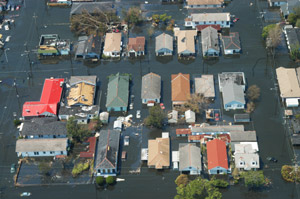Draining the Streets of New Orleans
Air Date: Week of September 9, 2005

(Photo: Liz Roll, courtesy of FEMA)
What lies in the water and beneath it is a question many people are asking as the so-called “toxic gumbo” of New Orleans pumps into Lake Pontchartrain and beyond. Host Steve Curwood talks with Darin Mann of the Louisiana Department of Environmental Quality about the extent of pollution in the city.
Transcript
CURWOOD: From the Jennifer and Ted Stanley Studios in Somerville, Massachusetts, this is Living on Earth. I'm Steve Curwood.
Hurricane Katrina did more than rip up the lands and structures of the Gulf Coast and flood out New Orleans. It also tore deep into the social fabric, scattering families, putting communities under pressure and highlighting America’s racial and economic divide. Now, the thick, blackish broth of water that covers New Orleans is raising concern among advocates of environmental justice. They worry that, as in the past, the poor and people of color in the region will be subjected to an excess amount of toxic pollution—or if their neighborhoods are cleaned up, they will be pushed out in a gentrified reconstruction.
We’ll visit those questions in a moment, but first, an update on what officials know now about the extent of pollution. Darin Mann is with the Louisiana Department of Environmental Quality. He's seen quite a bit of the city and he says he's finding no major pollution problems so far.
MANN: The preliminary water samples that we have obviously has high levels of fecal coliform, very low levels of lead, no VOCs, which is volatile organic compounds, pesticides, no metals, no herbicides, no PCBs, which, you know, we would consider priority pollutants. We have not seen any validated data that would indicate that – not to say it doesn’t exist – but we’re not finding it.
CURWOOD: Why do you think there’s so much lead in the water that’s been tested?
|
|
MANN: Well, the traces are very small. And a lot of that, the way I understand it, is attributed to many of the homes. Much of those homes down in the flooded area of New Orleans, they’re more than thirty years old, forty years old. What the scientists are telling me, it’s due to the lead-based paint. CURWOOD: But what about the chemicals though? MANN: The chemicals? What we’ve done is, as far as chemicals go, we’ve flown a helicopter that’s attached to an infrared gas imaging camera. What this camera does is, from the air, it can pick out or detect chemical leaks that the human eye just cannot see. We have not seen, through this technology, any major leaks, chemical leaks, of any kind. CURWOOD: Now, what does the Louisiana DEQ see as the biggest short-term problem right now? MANN: The biggest short-term problem is what we’re seeing from the air. As you fly down to the mouth of the river along the river you see quite a few oil spills. But in New Orleans, on the flooded area of Jefferson Parish and St. Bernard, there’s oil sheens everywhere. You have 2,000-plus gasoline stations that are submerged with three underground storage tanks each. So that creates an oil sheen. Cars. Every car’s gonna create an oil sheen. You’ve got well over 100,000 cars that were submerged. Murphy Oil, which is in Chalmette, Louisiana which borders a neighborhood, we had about between ten and fifteen thousand barrels of oil that seeped into a neighborhood. But this was a neighborhood that actually the houses were flooded to the rooftop. Other issues right now that we’re dealing with is the water that’s being pumped out of the city back into the lake. We’re monitoring the effect that that is gonna have onto the lake. Once the water is drained out of the city then the biggest problem I think that we’re going to be dealing with is how do we dispose of between 22 and 25 million tons of debris. And that’s going to be a challenge. CURWOOD: Darin Mann is with the Louisiana Department of Environmental Quality. Darren, thanks so much for taking this time with me today. MANN: Thank you, I appreciate it. Living on Earth wants to hear from you!Living on Earth Newsletter [Click here]
Donate to Living on Earth! NewsletterLiving on Earth offers a weekly delivery of the show's rundown to your mailbox. Sign up for our newsletter today!
|






